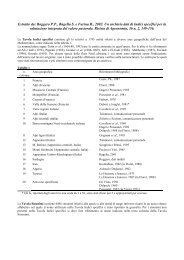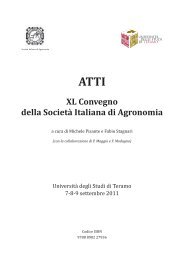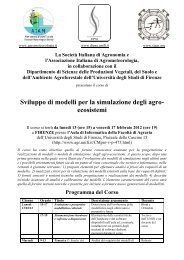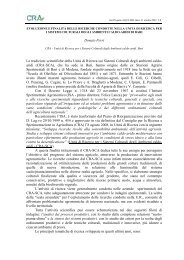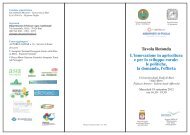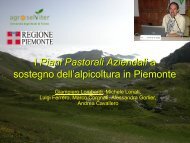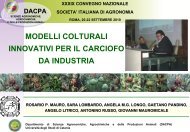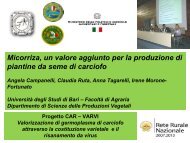You also want an ePaper? Increase the reach of your titles
YUMPU automatically turns print PDFs into web optimized ePapers that Google loves.
122 Baldini et al.<br />
Analysis of variance was done on the data, and<br />
when the F test proved significant, Duncan’s<br />
test at P ≤ 0.05 was used to separate the mean<br />
values of the treatments. For the data from the<br />
samples taken during the crop cycle the sources<br />
of variation were water regime and sampling<br />
date in the first year, and water regime, hybrid<br />
and sampling date in the second.<br />
RESULTS AND DISCUSSION<br />
Figure 1 shows achene dry matter accumulation<br />
during maturation. As the statistical analysis<br />
demonstrated that the hybrid effect was not significant,<br />
the values reported are the means of<br />
the two hybrids. It should be pointed out that<br />
at the first sampling (two days after the end of<br />
flowering), the embryo begins to form and<br />
therefore all the values relating to that date refer<br />
principally to the tissues of the seed coat,<br />
which forms and develops independently of fertilisation.<br />
The most significant increase in dry<br />
weight took place between 8 and 14 days after<br />
flowering, while between 20 and 28 days dry<br />
matter accumulation in the achene is more or<br />
less completed. Between treatments, water<br />
stress determined the formation of lighter achenes<br />
at maturity compared to the other treatments,<br />
with a higher growth rate in the earliest<br />
stages (8 days after fertilisation), thus confirming<br />
the findings of Hall et al. (1985). Figure 2<br />
shows a strong increase in oil accumulation in<br />
the achene (the values are the mean of the two<br />
hybrids), between the 8th and 14th days after fertilisation,<br />
in correspondence to the significant<br />
Figure 1. 1998. Time course of dry matter accumulation in<br />
achenes of plants submitted to water table (), ET () and<br />
stress () water regimes. The values reported refer to the<br />
mean of the two cv. The vertical bars represent the standard<br />
error of the mean.<br />
Figure 2. 1998. Time course of oil accumulation in achenes<br />
of plants submitted to water table (), ET () and stress<br />
() water regimes. The values reported refer to the mean<br />
of the two cv. The vertical bars represent the standard error<br />
of the mean.<br />
increase in dry matter in the achene (Figure 1).<br />
Among water regimes, the supply from the water<br />
table determined, at maturity, significantly<br />
higher percentages of oil in the achene than in<br />
the other irrigation regimes. However, all treatments<br />
reached the maximum oil content on the<br />
20 th day after the end of flowering, confirming<br />
what Champolivier and Merrien (1996) found<br />
in a trial conducted in a phytotron at the highest<br />
temperatures (27 °C day and 22 °C night),<br />
which are roughly equivalent to those at the trial<br />
site during post-flowering (Table 1).<br />
Figures 3 and 4 give the accumulation of the<br />
major fatty acids in the oil of the high oleic and<br />
standard hybrids for both years.<br />
In the first year of the trial the saturated fatty<br />
acids content (palmitic and stearic) in the high<br />
oleic hybrid diminished rapidly in the days following<br />
the end of flowering, to then stabilise between<br />
the 17 th and 23 rd day at approx. 2.5 and<br />
4%, respectively (Figure 3). The oleic acid content<br />
at the first sampling (74%) was significantly<br />
lower than that found at full-ripening (85%),<br />
while linoleic acid, on the contrary, had a value<br />
of 10% at the first sampling against 5% at maturity.<br />
Both these fatty acids stabilised between<br />
the 17 th and 23 rd day after the end of flowering<br />
(Figure 3).<br />
In the second year the palmitic acid trend<br />
seemed analogous in the two hybrids, with a<br />
slightly higher final amount in the standard hybrid<br />
(5.5%) than in the high oleic one (3%).<br />
This fatty acid reduced, compared to the initial



